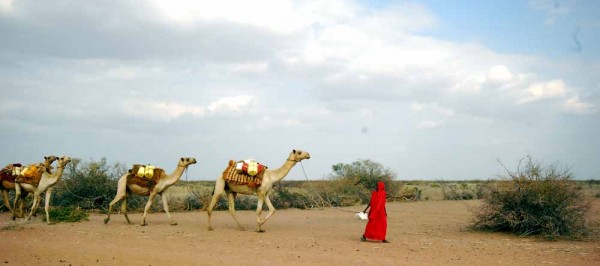In "Forgotten Kenya," mobile classrooms follow in nomads' footsteps
Siena AnstisWebsite

A nomadic Somali woman leads her camels in the drought-afflicted north of Kenya. Photo by Siena Anstis.
The drought in Northern Kenya this year is severe. Farah Olad, the Deputy Chief of Party of Education for Marginalized Children of Kenya (EMACK), an organization which works with Somali pastoral communities, tells me grey is the “color of death” in this rural region.
And the whole landscape is grey: from the ground to the pinky-sized thorns on the low-lying trees that populate the desert. Within minutes of leaving the paved highway leading out of Garissa, the biggest city between Nairobi and Mogadishu, I am greeted by the ominous sight of two dead goats.
Northern Kenyans are primarily pastoral ethnic Somalis. Many call the region “the forgotten Kenya” and characterize it as under the partial authority of wealthy Somali businessmen.
For centuries, these nomadic groups have crossed the borders of Ethiopia, Kenya and Somalia with little regard for politics. Their one mission, to maintain their herd, was fulfilled through the graces of nature and a predictable climate: long and short rainy seasons, as well as a limited dry spell.
However, climate change has brought new challenges: an extended dry season, no short rains this year and the potential of an El Niño long rain accompanied by violent flash floods in December.
Pastoral communities are aware of the ticking time-bomb that comes with their lifestyle. While, as Olad says, most would herd their goats, cows and camels into the depths of a war-torn country like Somalia to maintain their livelihood and culture, many understand that their lifestyle will not suffice for all. Increasingly, pastoral communities rely on the capacity of the uninterested central Kenyan government to deliver relief services and help them build alternatives to their unstable lifestyle.
One way of addressing this problem—and ensuring equitable representation of Somali Kenyans within their host country—is through secular education. Education offers alternatives: it gives children the possibility of thinking for themselves, as a part of a wider Kenya, and ensuring that they understand that there are choices. However, as families move year-round, there is little means for a child to access the formal primary school system.
Through mobile schools, the Nomadic Heritage Association (NOHA) and EMACK, are attempting to bring the next generation of nomadic Somalis this choice. They foresee the escalating difficulties pastoralists will face as potential “climate refugees.”
Each nomadic community is made up of an average seven households, all led by a head man. These communities follow pasture and water with their herds. Mobile schools follow these communities. As Islamic education is key to Somali culture, each group already has a dugsi, or an Islamic learning school, which occupies a majority of young children’s time along with daily chores. Secular education is slowly being introduced through the mobile schools, which provide teaching materials and offer the opportunity to train a teacher from the community.
Classes focus on English, Kiswahili, and Math. In one mobile school, most children have learned to write their names. Their exercise books are filled with neatly drawn figures and calculations. For a community that has been illiterate for generations, this is a significant change. Many would call it self-empowering. As Olad says, “It is not about changing culture, but about strengthening existing culture.” The latter part means ensuring that Somali communities can maintain their culture through a network made of a younger generation who speak the languages of both their Somali homes and of Kenya at large.
For more photos, please visit Welcome to “Forgotten Kenya.”